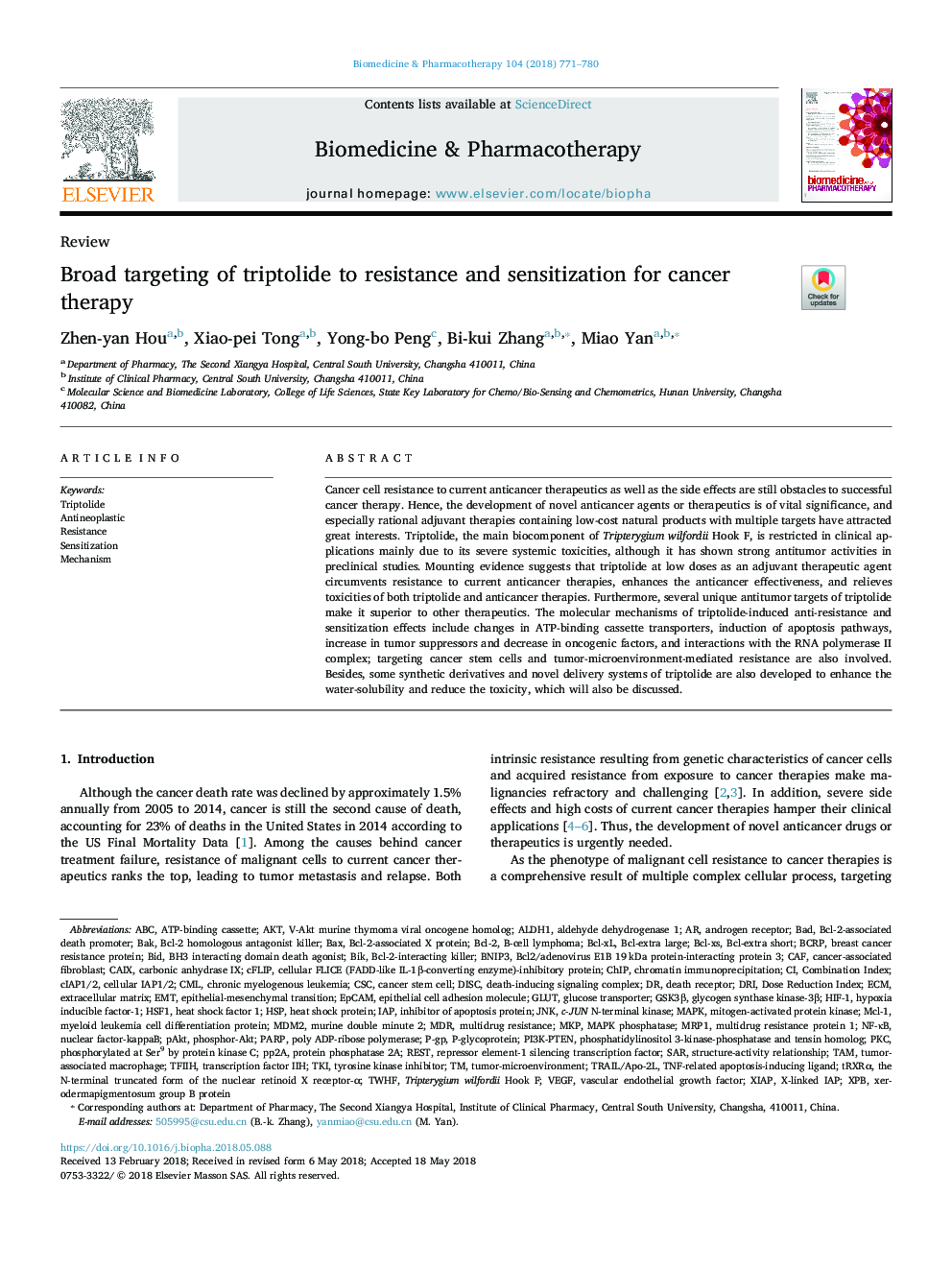| Article ID | Journal | Published Year | Pages | File Type |
|---|---|---|---|---|
| 8524720 | Biomedicine & Pharmacotherapy | 2018 | 10 Pages |
Abstract
Cancer cell resistance to current anticancer therapeutics as well as the side effects are still obstacles to successful cancer therapy. Hence, the development of novel anticancer agents or therapeutics is of vital significance, and especially rational adjuvant therapies containing low-cost natural products with multiple targets have attracted great interests. Triptolide, the main biocomponent of Tripterygium wilfordii Hook F, is restricted in clinical applications mainly due to its severe systemic toxicities, although it has shown strong antitumor activities in preclinical studies. Mounting evidence suggests that triptolide at low doses as an adjuvant therapeutic agent circumvents resistance to current anticancer therapies, enhances the anticancer effectiveness, and relieves toxicities of both triptolide and anticancer therapies. Furthermore, several unique antitumor targets of triptolide make it superior to other therapeutics. The molecular mechanisms of triptolide-induced anti-resistance and sensitization effects include changes in ATP-binding cassette transporters, induction of apoptosis pathways, increase in tumor suppressors and decrease in oncogenic factors, and interactions with the RNA polymerase II complex; targeting cancer stem cells and tumor-microenvironment-mediated resistance are also involved. Besides, some synthetic derivatives and novel delivery systems of triptolide are also developed to enhance the water-solubility and reduce the toxicity, which will also be discussed.
Keywords
ECMABCCSCNF-κBCAFSARMDRJnkDRIHIF-1ALDH1Mcl-1Bcl-2PP2ACMLHspPKCIAPDISCGSK3βBNIP3HSF1Bcl-xLPARPBcrpGLUTpAktEpCAMCAIXTKITriptolidecFLIPP-gpXIAPMKPMRP1TWHFTripterygium wilfordii Hook FTFIIHtranscription factor IIHBcl-2 homologous antagonist killerXPBBcl-XSrepressor element-1 silencing transcription factorX-linked IAPBH3 Interacting Domain Death Agonistc-Jun N-terminal kinaseMAPKMAPK phosphataseMdm2P-glycoproteinv-akt murine thymoma viral oncogene homologaldehyde dehydrogenase 1Aktantineoplasticchromatin immunoprecipitationReSTBaxBADBIKTAMEMTSensitizationGlucose transportermurine double minute 2Structure-activity relationshipcancer stem cellcombination indexdose reduction indexhypoxia inducible factor-1heat shock factor 1Vascular endothelial growth factorVascular Endothelial Growth Factor (VEGF)nuclear factor-kappaBcancer-associated fibroblastB-cell lymphomachronic myelogenous leukemiaTNF-related apoptosis-inducing ligandExtracellular matrixTumor-associated macrophageBcl-2-associated death promoterResistanceMultidrug resistanceTyrosine kinase inhibitorinhibitor of apoptosis proteinepithelial cell adhesion moleculeMechanismBcl-2-associated X proteinHeat shock proteinprotein phosphatase 2Abreast cancer resistance proteinmultidrug resistance protein 1mitogen-activated protein kinaseBAKpoly ADP-ribose polymeraseBIDdeath-inducing signaling complexCHiPCarbonic anhydrase IXATP-binding cassetteEpithelial-mesenchymal transitionGlycogen synthase kinase-3βAndrogen Receptordeath receptor
Related Topics
Health Sciences
Medicine and Dentistry
Oncology
Authors
Zhen-yan Hou, Xiao-pei Tong, Yong-bo Peng, Bi-kui Zhang, Miao Yan,
